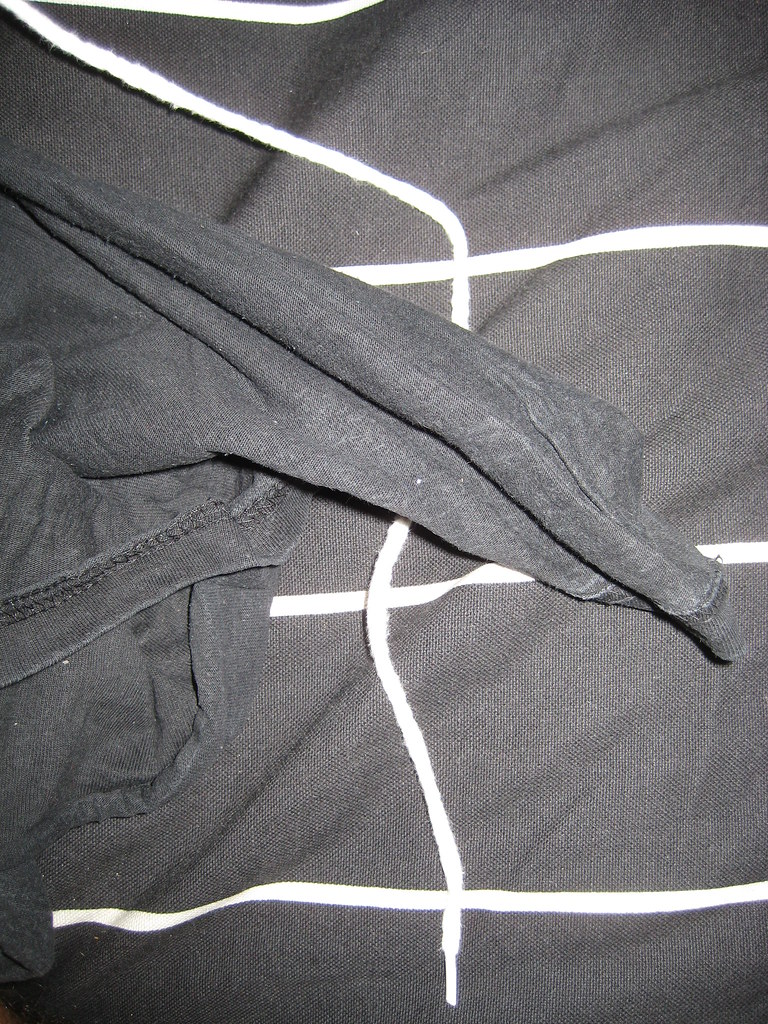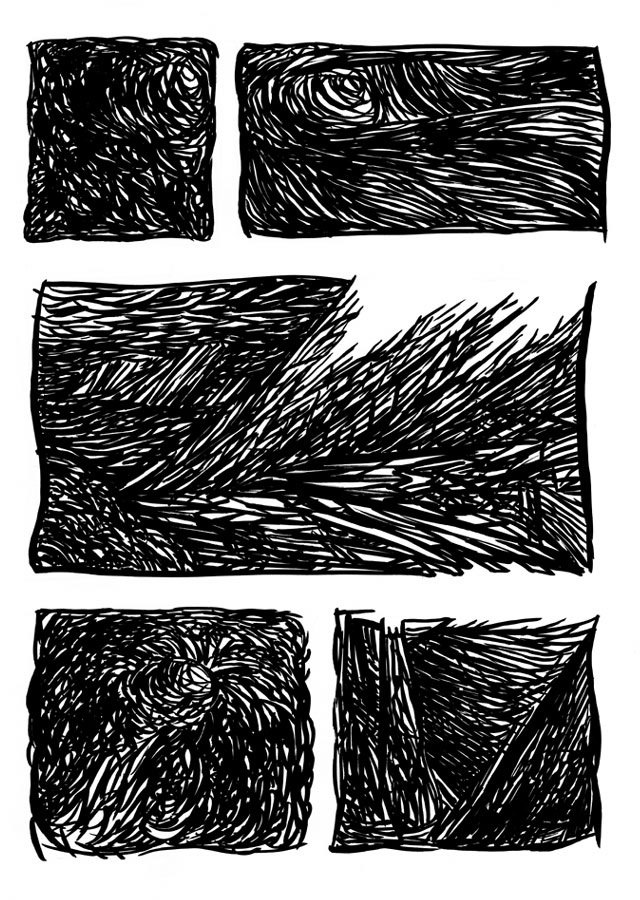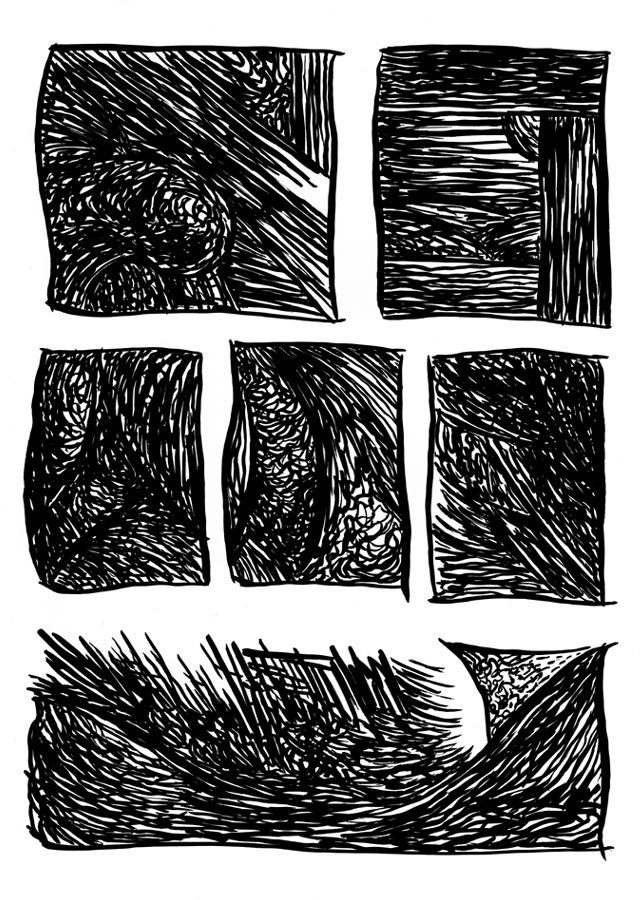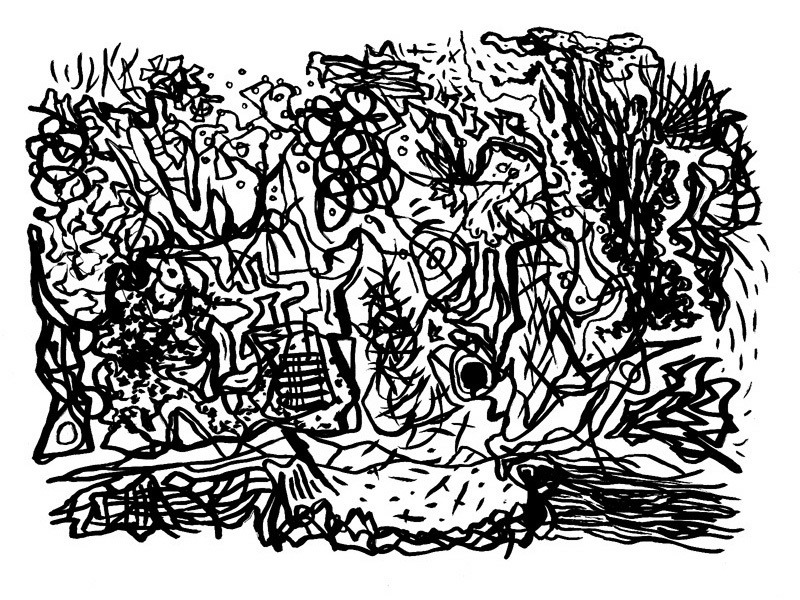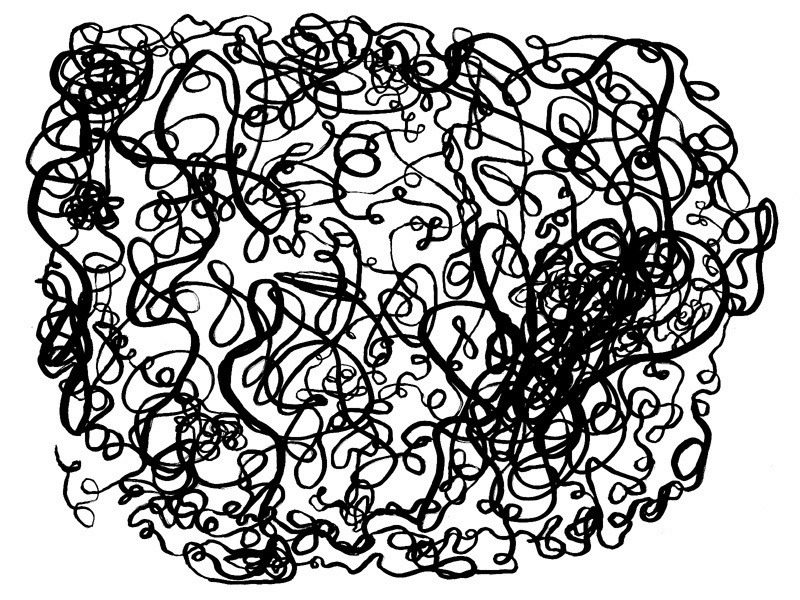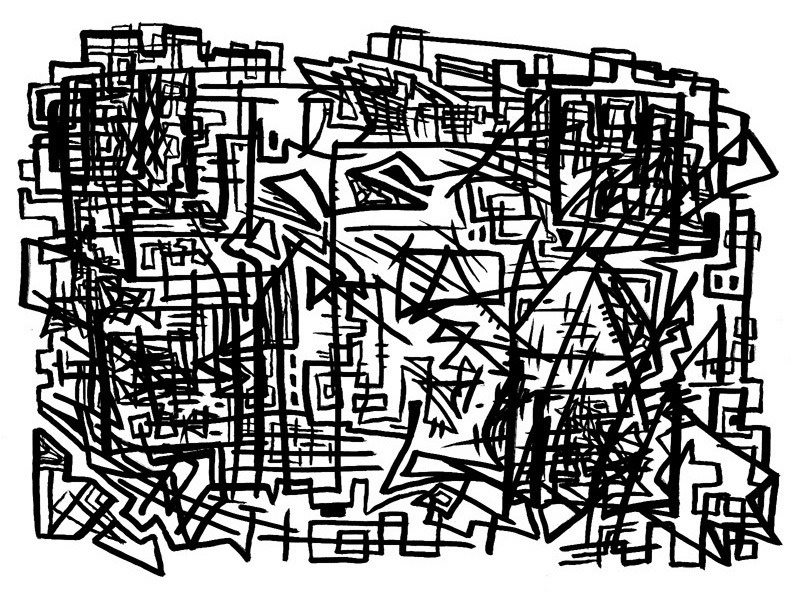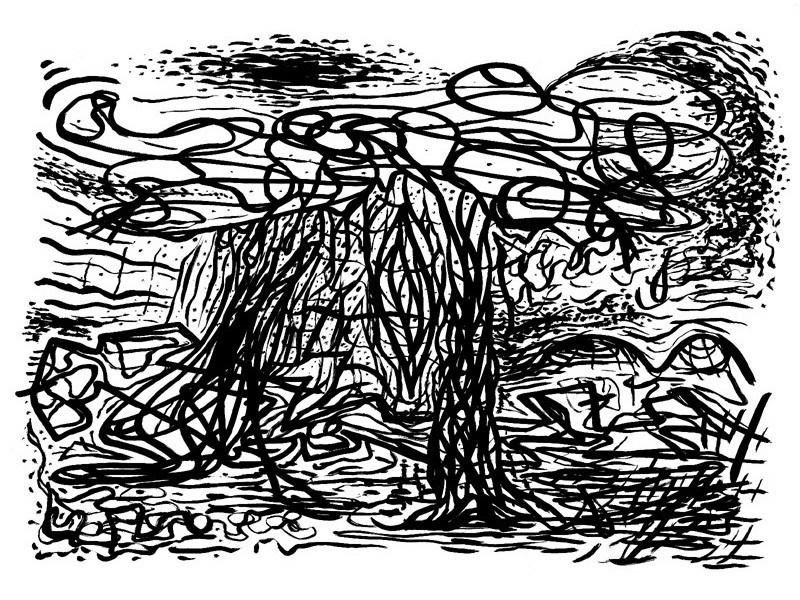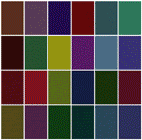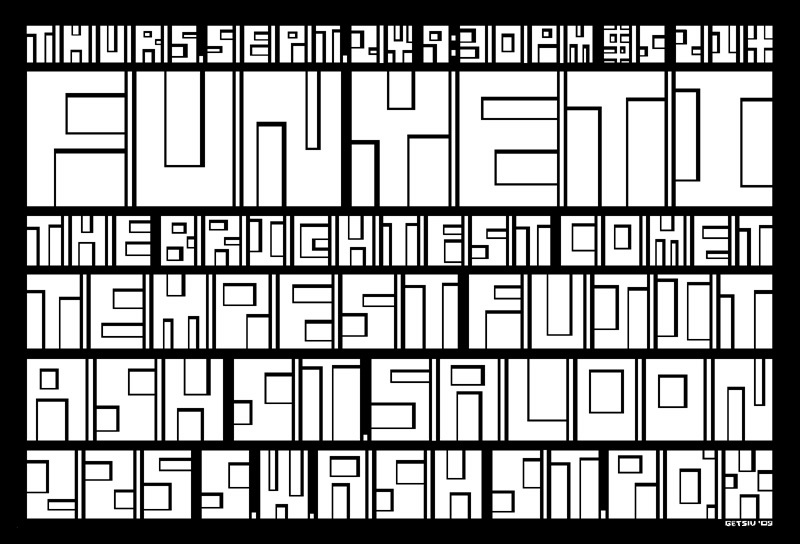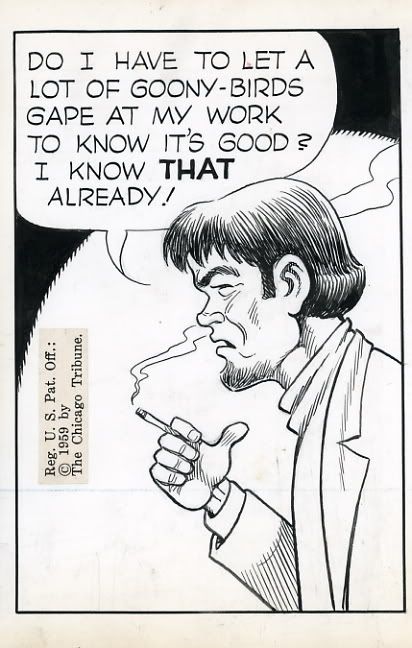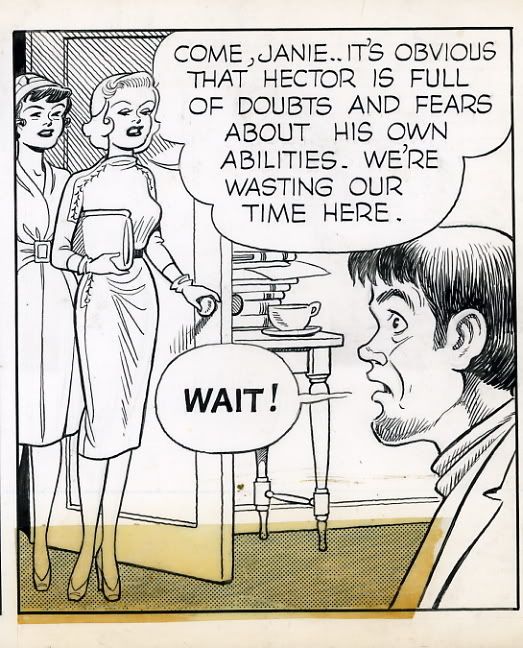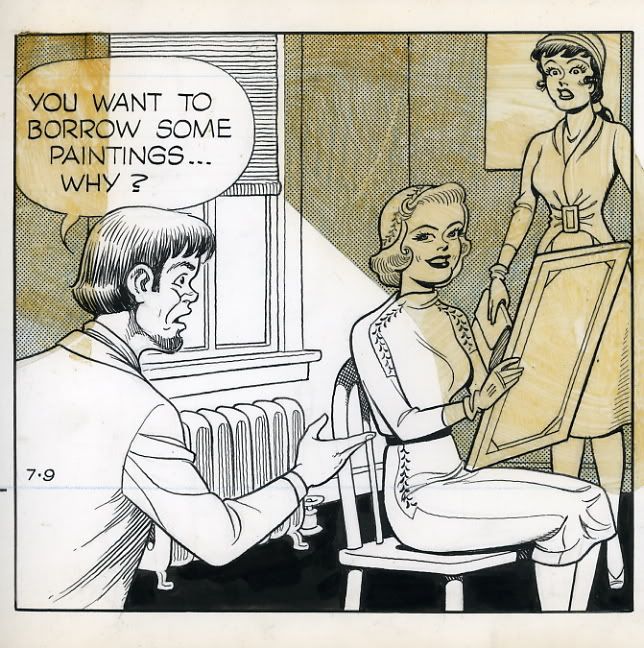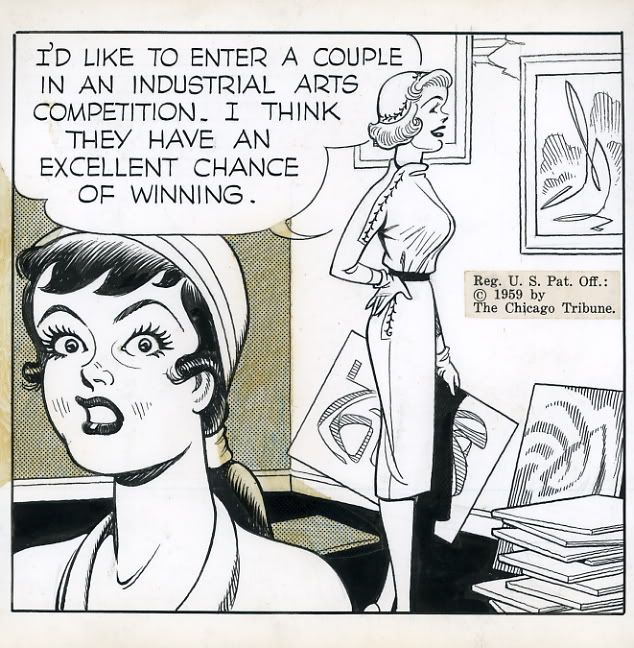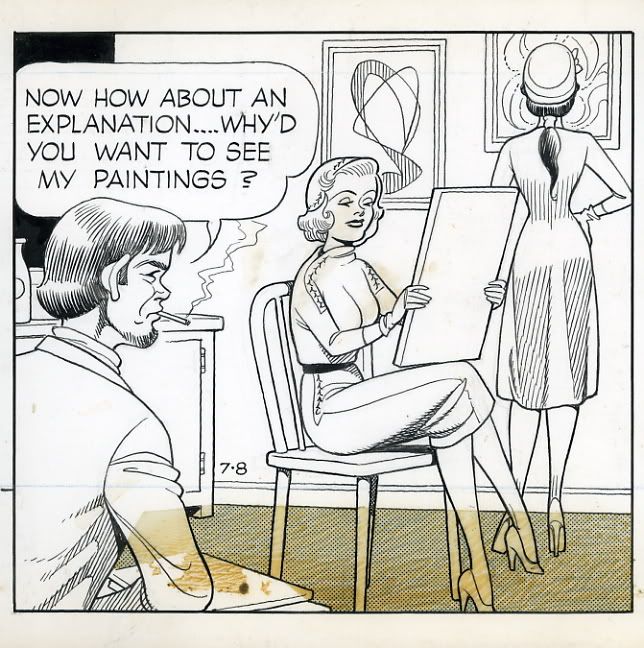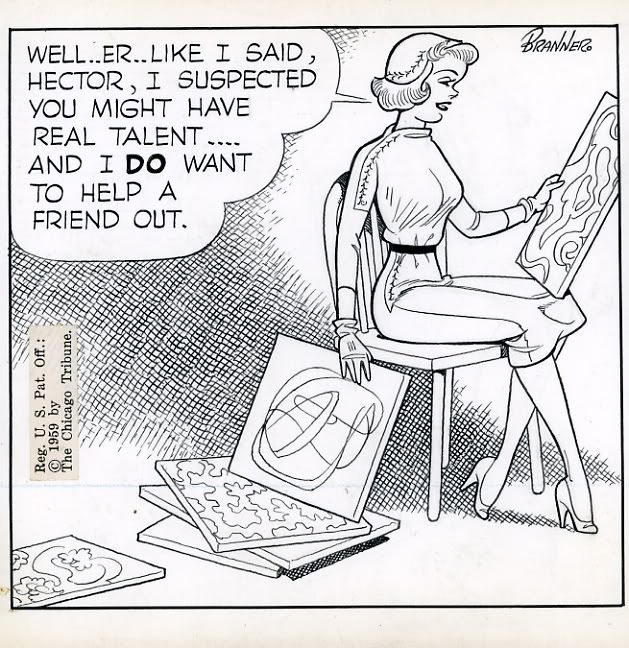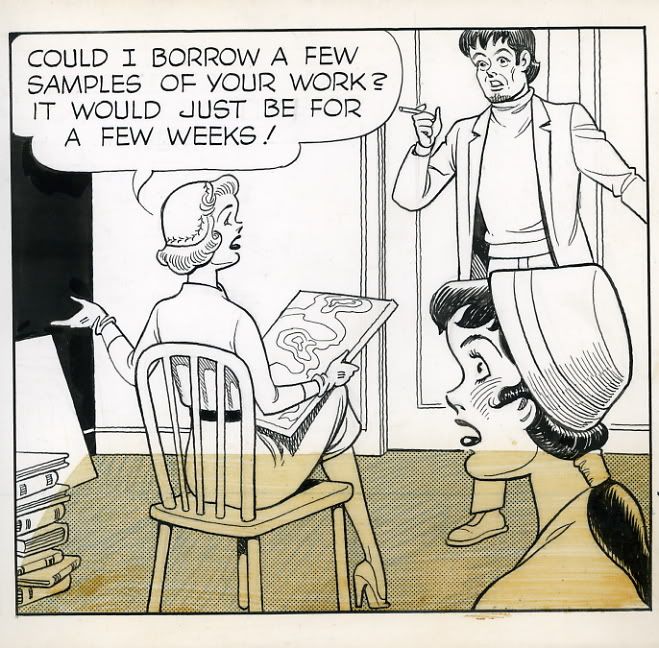I had a brand new big post (and, yes, about actual comics!) ready to go, but Photobucket is down for maintenance tonight, so I'll have to post it tomorrow. In the meantime, here's another cool abstract thingy I found on YouTube:
Tuesday, September 29, 2009
Monday, September 28, 2009
What's Next?
So now that the exhibition is up and the books is out, how can we use this community forum? I've got some ideas--would you be interested in doing any of the below?
- Sequential abstract story with different artists: We could have someone start a story, and then another artist chime in with the next section, and so on (one by one).
- Simultaneous abstract story with different artists: Similar to Andrei's evolutionary drawings before, we could have reinterpretations of a single piece, building on top of one another's work.
- Further thematic exhibitions or gallery events: We could get a group together to respond to a specific prompt and have an abstract comics event on that topic.
- Any other ideas or suggestions?
Thursday, September 24, 2009
"An abstract told comic story"
I found this on YouTube (linked to as a "related video" on the page with Pedro's Anthology preview), and just had to share:
Around the world around the world...
Review of the Anthology in the Berlin daily newspaper Der Tagesspiegel
Iffy Google translation of same
Further blog post by writer of Der Tagesspiegel review, in English
Review by Pedro Moura from Portugal, in Portuguese
Basically incomprehensible Google translation of same (must be something about the syntax of Portuguese...)
Japanese-language review of "Silent Pictures"
Google translation of same
The extremely tentative accuracy of the Google translations basically exempts me from trying to excerpt them, but scan them and see if you can get the basic gist for each. They seem to be very good reviews, as far as I can tell!
Also from Pedro, I should add, comes this pretty cool YouTube preview of the Anthology:
And, as long as I'm embedding videos:
Play both of them at once!!
Iffy Google translation of same
Further blog post by writer of Der Tagesspiegel review, in English
Review by Pedro Moura from Portugal, in Portuguese
Basically incomprehensible Google translation of same (must be something about the syntax of Portuguese...)
Japanese-language review of "Silent Pictures"
Google translation of same
The extremely tentative accuracy of the Google translations basically exempts me from trying to excerpt them, but scan them and see if you can get the basic gist for each. They seem to be very good reviews, as far as I can tell!
Also from Pedro, I should add, comes this pretty cool YouTube preview of the Anthology:
And, as long as I'm embedding videos:
Play both of them at once!!
Tuesday, September 22, 2009
Sunday, September 20, 2009
Three more in black and white...
1. Shoreflight (2003)
I had rejected this one from being considered a comic but now I'm reconsidering:
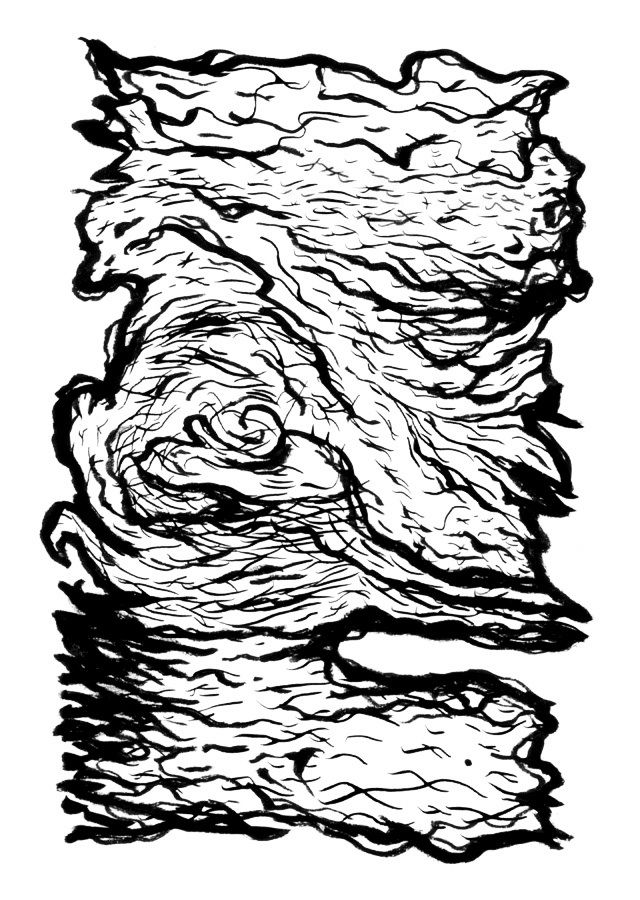
This one I made leading up to the 2004 U.S. Presidential Election (It had absolutely zero effect on the outcome):
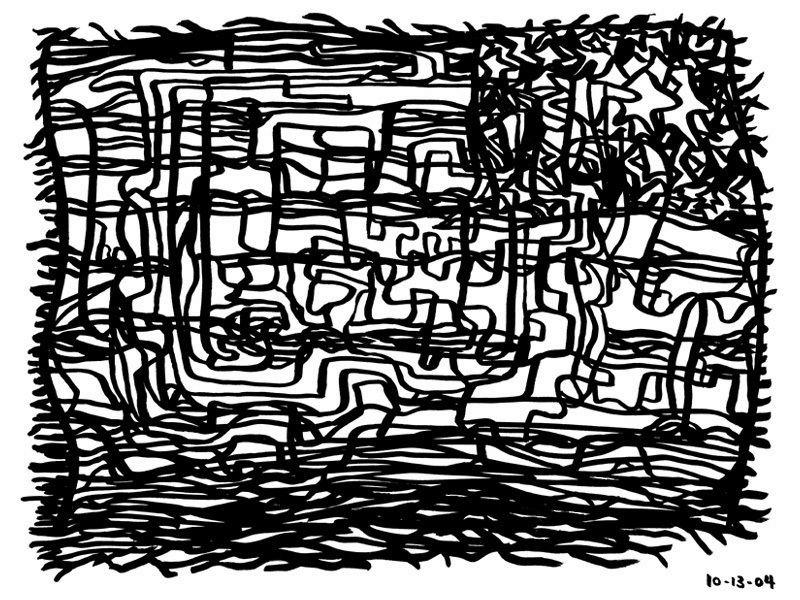

Last year, this one was displayed in City Hall here in Portland, Oregon
during Comics Month which is April, as decreed by our mayor (I'm not kidding):
Thanks again for looking!
Saturday, September 19, 2009
Review of "Silent Pictures" on SVA Continuing Education blog
Again, hard to excerpt. Read it here. It also has a lot of nice pics of the installation.
Thursday, September 17, 2009
And another two reviews...
Sara Cole at PopMatters:
...Abstract Comics makes explicit that the line between comics and high art is beginning to disappear.
...Abstract Comics does a superb job of implicitly proving how comics make meaning without any real recourse to narrative. We glean meaning from comics instead via the juxtaposition and rhythm of frames placed alongside of each other. The placement of frames need not communicate a narrative, as the book shows, but instead might give a sense of movement or mood via the choice of colors and shapes displayed across a series of panels. Much like early film experiments by Hans Richter, Abstract Comics collects works by various artists who are indeed trying to work out the question what can be expressed through the specific medium of comics, without recourse to traditional narrative paradigms.
...Abstract Comics is a necessary addition to the comics canon in that it forces us to continue to think what exactly constitutes the comics form.
And Alan David Doane at Comic Book Galaxy:
...the images by Elijah Brubaker, Geoff Grogan and Janusz Jaworski use the panels and pages to create a sense of meaning and movement that invite multiple readings.
...Mike Getsiv's "Shapes," defines space with lines and colours inside irregular panel borders in a manner that appeals to the eye and is not wholly unsimilar to James Kochalka's stylings. Both use the tools at their disposal to suggest passion and emotion, and Getsiv's striking images are worthy of a collection all their own.
I really liked former Galaxy contributor Derik Badman's rambling, dream-like creations, too, suggesting partially obscured views into a world unseen, unknown and unknowable.
...Abstract Comics makes explicit that the line between comics and high art is beginning to disappear.
...Abstract Comics does a superb job of implicitly proving how comics make meaning without any real recourse to narrative. We glean meaning from comics instead via the juxtaposition and rhythm of frames placed alongside of each other. The placement of frames need not communicate a narrative, as the book shows, but instead might give a sense of movement or mood via the choice of colors and shapes displayed across a series of panels. Much like early film experiments by Hans Richter, Abstract Comics collects works by various artists who are indeed trying to work out the question what can be expressed through the specific medium of comics, without recourse to traditional narrative paradigms.
...Abstract Comics is a necessary addition to the comics canon in that it forces us to continue to think what exactly constitutes the comics form.
And Alan David Doane at Comic Book Galaxy:
...the images by Elijah Brubaker, Geoff Grogan and Janusz Jaworski use the panels and pages to create a sense of meaning and movement that invite multiple readings.
...Mike Getsiv's "Shapes," defines space with lines and colours inside irregular panel borders in a manner that appeals to the eye and is not wholly unsimilar to James Kochalka's stylings. Both use the tools at their disposal to suggest passion and emotion, and Getsiv's striking images are worthy of a collection all their own.
I really liked former Galaxy contributor Derik Badman's rambling, dream-like creations, too, suggesting partially obscured views into a world unseen, unknown and unknowable.
Brandl: Art Museum of Canton Thurgau Paintings Acquisition

It is a particular thrill for me to announce that the Art Museum of Thurgau in Switzerland has just acquired 20 paintings of mine! They comprise a representative cross-section of several years of my series titled "Covers," the majority of which fit into the "abstract comics" realm, much like my installation in the Silent Pictures exhibition. I am very pleased that they will be in such a great institution and under the care of its eminent director Markus Landert and curator Dorothee Messmer!
Abstract Art Jam
September 10, 2009, "Under the Volcano" pub, E 36th St., NYC, sometime after 10 pm. Culprits (in order of appearance): Kevin Mutch, Nina Roos, yours truly, Richard Hahn, Matt Madden.

For some reason, Matt and Kevin felt obliged to disavow that unobtrusive toot...

For some reason, Matt and Kevin felt obliged to disavow that unobtrusive toot...
Wednesday, September 16, 2009
Brett Bergmann, "The Noise of Their Leaving"
Blog reader Brett Bergmann sent me a link to his short abstract film, "The Noise of Their Leaving," which is composed of "background elements from a famous mid-century French film... meticulously sampled, cropped, and displaced." If you know your history of cinema at all, you'll be able to figure out the source even before the end credits. Brett also describes it as "an abstract piece of visual non-narrative," which fits in pretty well with what we all do over here. I think it's gorgeous, and only wish it were longer.
Tuesday, September 15, 2009
pix
here are a couple shots. the first one tickles me, as it shows all the various, tristate-area luminaries of abstract comics reading my book (lumakick #2). thanks to jeffrey and julie of jim hanley's universe and all two people who showed up for the signing (lou and jean anne!)

(from left to right: Janusz Jaworski, Patrick McDonnell, Alexey Sokolin, Andrei Molotiu)
here's a shot at the CUNY james gallery. thanks to linda norden and anna conlan for organizing and hanging a stellar exhibition

(center: the back of henrik rehr's head)
on another note entirely, it was great to see/meet you guys over the weekend: andrei, janusz, alexey, patrick, derik, henrik, anders, nina and nik roos, and karl and oliver from mocca. hope to see you guys again when the movie comes out

(from left to right: Janusz Jaworski, Patrick McDonnell, Alexey Sokolin, Andrei Molotiu)
here's a shot at the CUNY james gallery. thanks to linda norden and anna conlan for organizing and hanging a stellar exhibition

(center: the back of henrik rehr's head)
on another note entirely, it was great to see/meet you guys over the weekend: andrei, janusz, alexey, patrick, derik, henrik, anders, nina and nik roos, and karl and oliver from mocca. hope to see you guys again when the movie comes out
Monday, September 14, 2009
Two more anthology reviews
As I've been really busy with installing the show and then preparing for all the events of the last weekend, I neglected to mention a couple of reviews we got. First of all, here is Paul Dwyer's wonderful review of the book that he posted on Amazon, and which he has allowed me to reprint in full:
Since their ostensible beginnings as passing amusements in the pages of 19th century newspapers, comics have had their peaks (the praises heaped upon George Herriman's Krazy Kat by the literati of the 1920s and 30s; Art Spiegelman's Pulitzer Prize for Maus) and valleys (Frederic Wertham's Seduction of the Innocent) when it has come to acceptance as a genuine art. The slow rise in recognition the graphic novel has received over the course of the past two decades (from Watchmen and Maus to Jimmy Corrigan and Asterios Polyp) has gone a long way toward a wider acceptance of the form. With the publication of Abstract Comics: The Anthology, comics may be moving definitively in the direction of art-as-a-given territory and away from "comics aren't just for kids anymore" qualifiers.
When approaching Abstract Comics some reader reorientation may be required. Robert S. Peterson laments in his review that he was hoping for a book he could "open up and pour over" in the same manner he would Tom Phillips' A Humument (a brilliant piece of visual poetry). The reason for this defeated expectation may lie in the optimal method of digestion of one work vs the other. While A Humument may bear some resemblance to the works on display in Abstract Comics, it is a book composed of both words and pictures with the latter being composed of pictures exclusively. You can read A Humument as you would any work of comics, reading text while simultaneously taking in visuals. Reading Abstract Comics requires a different process of digestion as the normal vehicle of assimilating a narrative (text) is absent. The reader is not even aided by the presence of representational visuals as one might be in a more typical wordless comic or woodcut novel. You should approach these works in a manner similar to the way you might view a painting or sculpture. Look. Stare. Spend some time with each panel. See what it has to say. Think about it one way then another. There's nothing to decipher in the sense of a decoder ring or elaborate puzzle.
The range of works here are impressive. Some standouts for me (along with some subjective interpretations and comparisons) include: Blaise Larmee's I Would Like to Live There, a minimal but highly evocative piece, suggesting a lonely but inviting world of life just outside a city (possibly a homeless encampment); Derik Badman's Flying Chief, simple and meditative, it reminds me of Asian woodblock prints (it's also interesting from a formal perspective as detailed in the artist's bio); Mark Badger's Kung Fu (the original 1980 version), another interesting formal experiment, reminds me of that most comics-like of Cubist works, Duchamp's Nude Descending A Staircase; editor Andrei Molotiu's The Panic is the closest piece here that brings to mind the psychic energy of Kirby-style superhero comics with its heavy chaotic blacks over luminous colors; and Janusz Jaworski's various pieces that come off like comic strips from the Codex Seraphinianus.
The only complaint I can make is that the book may be too short. Full pages of the precursor paintings that are reproduced small in the introduction (a Google image search fails to reveal Jasper Johns' Alley Oop) and the addition of a semi-lengthy piece (15-25 pages or so) could possibly have provided a fuller picture of abstract comics' abilities. Regardless, this is a small quibble with a book that may represent a course change in how comics are perceived and produced in the coming years.
Paul, I should add, is the creator behind the wonderful conceptual comic Codex Optica:

Then there is John Hogan's great review at Graphic Novel Reporter:
...Molotiu has created a fun and accessible anthology here, one that’s smart and well-researched but not in the slightest bit obtuse. You don’t need to be an art snob to appreciate it; you just need an open mind. With that, the reward for Abstract Comics is quite lovely. And quite possibly a good opportunity for you to increase your appreciation for the comics format exponentially.
Since their ostensible beginnings as passing amusements in the pages of 19th century newspapers, comics have had their peaks (the praises heaped upon George Herriman's Krazy Kat by the literati of the 1920s and 30s; Art Spiegelman's Pulitzer Prize for Maus) and valleys (Frederic Wertham's Seduction of the Innocent) when it has come to acceptance as a genuine art. The slow rise in recognition the graphic novel has received over the course of the past two decades (from Watchmen and Maus to Jimmy Corrigan and Asterios Polyp) has gone a long way toward a wider acceptance of the form. With the publication of Abstract Comics: The Anthology, comics may be moving definitively in the direction of art-as-a-given territory and away from "comics aren't just for kids anymore" qualifiers.
When approaching Abstract Comics some reader reorientation may be required. Robert S. Peterson laments in his review that he was hoping for a book he could "open up and pour over" in the same manner he would Tom Phillips' A Humument (a brilliant piece of visual poetry). The reason for this defeated expectation may lie in the optimal method of digestion of one work vs the other. While A Humument may bear some resemblance to the works on display in Abstract Comics, it is a book composed of both words and pictures with the latter being composed of pictures exclusively. You can read A Humument as you would any work of comics, reading text while simultaneously taking in visuals. Reading Abstract Comics requires a different process of digestion as the normal vehicle of assimilating a narrative (text) is absent. The reader is not even aided by the presence of representational visuals as one might be in a more typical wordless comic or woodcut novel. You should approach these works in a manner similar to the way you might view a painting or sculpture. Look. Stare. Spend some time with each panel. See what it has to say. Think about it one way then another. There's nothing to decipher in the sense of a decoder ring or elaborate puzzle.
The range of works here are impressive. Some standouts for me (along with some subjective interpretations and comparisons) include: Blaise Larmee's I Would Like to Live There, a minimal but highly evocative piece, suggesting a lonely but inviting world of life just outside a city (possibly a homeless encampment); Derik Badman's Flying Chief, simple and meditative, it reminds me of Asian woodblock prints (it's also interesting from a formal perspective as detailed in the artist's bio); Mark Badger's Kung Fu (the original 1980 version), another interesting formal experiment, reminds me of that most comics-like of Cubist works, Duchamp's Nude Descending A Staircase; editor Andrei Molotiu's The Panic is the closest piece here that brings to mind the psychic energy of Kirby-style superhero comics with its heavy chaotic blacks over luminous colors; and Janusz Jaworski's various pieces that come off like comic strips from the Codex Seraphinianus.
The only complaint I can make is that the book may be too short. Full pages of the precursor paintings that are reproduced small in the introduction (a Google image search fails to reveal Jasper Johns' Alley Oop) and the addition of a semi-lengthy piece (15-25 pages or so) could possibly have provided a fuller picture of abstract comics' abilities. Regardless, this is a small quibble with a book that may represent a course change in how comics are perceived and produced in the coming years.
Paul, I should add, is the creator behind the wonderful conceptual comic Codex Optica:

Then there is John Hogan's great review at Graphic Novel Reporter:
...Molotiu has created a fun and accessible anthology here, one that’s smart and well-researched but not in the slightest bit obtuse. You don’t need to be an art snob to appreciate it; you just need an open mind. With that, the reward for Abstract Comics is quite lovely. And quite possibly a good opportunity for you to increase your appreciation for the comics format exponentially.
Photos?
Any chance that some photos of the exhibition and/or the opening reception can be posted? I would love to see some since I couldn't make it.
Sunday, September 13, 2009
Random Comics / Abstraction in Narrative
Some of you heard me mention this project at the MoCCA panel. One direction that I think you can also abstract comics is by abstracting the narrative. This can be done by removing the deterministic nature of intended sequencing. In other words, let go of your story and see how it behaves using the formal elements and sheer luck.
In the project below, there are approximately 100 images and 500 lines of text that get filtered into 4 panels and 3 lines of text. On refresh, a new page is generated. I would posit that a new story, or at least a new visual poem, is generated. Try it out!
http://www.sokolindesign.com/experiment/comic/index.php

In the project below, there are approximately 100 images and 500 lines of text that get filtered into 4 panels and 3 lines of text. On refresh, a new page is generated. I would posit that a new story, or at least a new visual poem, is generated. Try it out!
http://www.sokolindesign.com/experiment/comic/index.php

Saturday, September 12, 2009
Thank You, New York!
There was standing room only today at the Abstract Comics panel at MoCCA! And thank you panelists, great discussion. Thursday's opening of "Silent Pictures" was very well attended too, and we got some enthusiastic responses. Overall, a great Ab Cmx weekend in the Big Apple. I'll write more once I get back home and I'm not typing on a tiny tiny keyboard...
Peanuts Cover
Here's a semi-abstract cover version of Peanuts April 18th, 1966, I made as a hybrid with one of my Eyeballs characters in a more flat cutout style. The dotted and motion lines are sampled from Schulz's original strip.
Friday, September 11, 2009
Over There Biting the Hand That Obscurely Vshzibmph
I'm actually more of a critic than an artist...so I've done what I do best (relatively speaking) and reviewed the anthology over on my own blog.
Short version: I liked some of the work a lot, some of it not so much, but I was impressed with the case it made for abstract comics as a coherent, albeit incipient, tradition, and felt lucky to have been a part of it.
Short version: I liked some of the work a lot, some of it not so much, but I was impressed with the case it made for abstract comics as a coherent, albeit incipient, tradition, and felt lucky to have been a part of it.
Action Figures

this is a page from Michael Jacobson's Action Figures.
comics, or not?
there's an e-book edition published by me, in A4 page size: http://avance.randomflux.info/
an e-book edition with an introduction by me, in US page size: http://www.literatemachine.com/product/michael-jacobson/action-figures
or you can buy a glorious lo-fi paperback copy: http://www.lulu.com/content/paperback-book/action-figures/5728952
we all know the categories of conventional novels & graphic novels, but what about those things in between, like Michael's Action Figures & The Giant's Fence, Rosaire Appel's books, Cementimental's book, Max Ernst's Une semaine de bonté & La femme 100 têtes, Raymond Federman's Double or Nothing & others?
& further, there are examples of mainly verbal fiction, which use a heavy dose of graphics. A good example: Fantomas contra los vampiros multinacionales, by Julio Cortázar, which has a mixture of straight text (en español), comics & other graphics. (thanks, Xavier, for showing me this.)
Zoë Sadokierski, a professional book designer & scholar, is researching typographically enhanced fiction: http://zoesadokierski.blogspot.com/ (there's a list of "Fictional prose with graphic elements" on the right hand side).
the first edition of volume 3 of Laurence Sterne's novel Tristram Shandy (1761) included a page of marbling, inspired by Turkish ebru marbling. Some commentators say that the author was trying to represent Tristram's state of mind.
Early September 2001
Thursday, September 10, 2009
Interview with Draw
Recently I did an email interview for a New Zealand Comics and Pop Culture Blog about the Abstract Comics Anthology. Where we discuss it and my abstract comics practice. Check it out here.
Extract:
Drawingsilence.com
Extract:
AK: You've also experimented with having content inside and outside of a panel grid, for example, Series 1 Abstract 8 set 'They are coming'. Did you find one effect more interesting than the other, or was it more about exploring the contrast between to two effects?
DRAW: I had an epiphany. The gutter is where all the action in a comic takes place, its where the reader creates the comic reading experience. The Abstract Seven set from series One is the first experiments I did looking into this. I wasn't trying to create effects, I was trying to create a visual representation of what happens in the gutter of a comic.
Drawingsilence.com
Wednesday, September 9, 2009
Tuesday, September 8, 2009
Monday, September 7, 2009
Confuratis from Requiem of Mozart

A kind of friend of me, perhaps at the viewing of this blog, have the project to
"draw" music. For her it was a kind of abstract Comic. You have here and extract
of the first page, the music is the Confuratis requiem from Mozart.
Sylvie-Anne ménard are teacher of classic music in Montreal university and comic
drawer from few years.
It was possible to hear music and see comic here :
Sunday, September 6, 2009
Saturday, September 5, 2009
Friday, September 4, 2009
Thursday, September 3, 2009
Abstract 18 Series 3 ‘Lines’
 Abstract 18 I like the rough and spontaneous aspect to this comic and how the dry brushing catches the wrinkle of the paper. This is another of my comics looking at the gutter and panel relationship.
Abstract 18 I like the rough and spontaneous aspect to this comic and how the dry brushing catches the wrinkle of the paper. This is another of my comics looking at the gutter and panel relationship.Drawingsilence.com
Wednesday, September 2, 2009
Well, that was quick! First review of "Silent Pictures"
...Breer’s tiny abstract flipbooks surreptitiously introduce the third - and largest - section of the show, comprised of abstract comics from the new book of the same title by Andrei Molotiu. Here, narrative art comes with most of the trappings of the comics, minus realistic imagery and, for the most part, a verbal stream. According to Molotiu, an artist and educator, the absence of a verbal story can create a feeling of sequential drive, rhythm, or the rise and fall of a story arc.
This idea characterizes much, but not all, of the art on display at the James. Collected through a worldwide open call, the work is done by artists who will be new for most visitors to the show. Among the standouts are
I am not married because I do not have a watch, by Noah Bertansky, in which the narrative drive of the art carries haphazardly framed panels screechingly across their paper background. The message seems to be that the artist’s life is a train wreck, due to his watch- and wife-lessness,
Jasnusz Jaworski takes the idea of abstract comics to the extreme by creating an abstract language for the speech bubbles that inhabit the frames in a style reminiscent of Japanese scroll painting and calligraphy. And an old-fashioned wire magazine stand hosts a collection of paintings by Mark Staff Brandt called A History of Composition in Abstract Comic Covers. Done in oil, acrylic and collage on masonite panels, the 30 pieces in this series have a wonderfully crude graphic style shared by realistic comics by R. Crumb and others of the East Village Eye era...
Read the whole thing here.
This idea characterizes much, but not all, of the art on display at the James. Collected through a worldwide open call, the work is done by artists who will be new for most visitors to the show. Among the standouts are
I am not married because I do not have a watch, by Noah Bertansky, in which the narrative drive of the art carries haphazardly framed panels screechingly across their paper background. The message seems to be that the artist’s life is a train wreck, due to his watch- and wife-lessness,
Jasnusz Jaworski takes the idea of abstract comics to the extreme by creating an abstract language for the speech bubbles that inhabit the frames in a style reminiscent of Japanese scroll painting and calligraphy. And an old-fashioned wire magazine stand hosts a collection of paintings by Mark Staff Brandt called A History of Composition in Abstract Comic Covers. Done in oil, acrylic and collage on masonite panels, the 30 pieces in this series have a wonderfully crude graphic style shared by realistic comics by R. Crumb and others of the East Village Eye era...
Read the whole thing here.
Tuesday, September 1, 2009
Contest part II: "Nautilus"
Ok, I guess that contest was too easy. It certainly was over in a flash. Marcus and Kevin are getting their prizes, but I decided the fun didn't last long enough, so here is one more chance to win. This time, I'll make it a copy of my book "Nautilus" with a big dedicatory doodle inside it, based on a word of your choosing. (Admittedly, this also gives me a chance to promote my own book on this here blog, which I've kept meaning to do but just never got around to. Until now.)
So, here it is, "Nautilus," published this summer by Fahrenheit Editions from Copenhagen. (But it's in English!) I have a couple of copies left, though I will get more in a couple of weeks. Distributor Tony Shenton has picked it up, so it should be available within the next month or so in your better comic-book shops--your Quimbys, your Million-Year Picnics.











So, here's the contest, and I daresay it will be harder than the previous one (though I've been known to be wrong). Identify this musician:


If nobody gets it in 2-3 days, I'll give more hints. I suppose I could do a contest asking you to identify some obscure piece of abstract art--but what fun would that be?
Of course, if you don't win, you can also order the book from me directly, for $23 postpaid (in the States). As I said, I should have a good number of copies arriving from Denmark in a couple of weeks. (I should add that, in stores, it will unfortunately have to be more more expensive than that.)
Oh--and Marcus and Kevin? If you know this one, please let someone else win. But email me with the identification, I'd be curious to see if someone gets it.
So, here it is, "Nautilus," published this summer by Fahrenheit Editions from Copenhagen. (But it's in English!) I have a couple of copies left, though I will get more in a couple of weeks. Distributor Tony Shenton has picked it up, so it should be available within the next month or so in your better comic-book shops--your Quimbys, your Million-Year Picnics.











So, here's the contest, and I daresay it will be harder than the previous one (though I've been known to be wrong). Identify this musician:


If nobody gets it in 2-3 days, I'll give more hints. I suppose I could do a contest asking you to identify some obscure piece of abstract art--but what fun would that be?
Of course, if you don't win, you can also order the book from me directly, for $23 postpaid (in the States). As I said, I should have a good number of copies arriving from Denmark in a couple of weeks. (I should add that, in stores, it will unfortunately have to be more more expensive than that.)
Oh--and Marcus and Kevin? If you know this one, please let someone else win. But email me with the identification, I'd be curious to see if someone gets it.
Subscribe to:
Posts (Atom)

